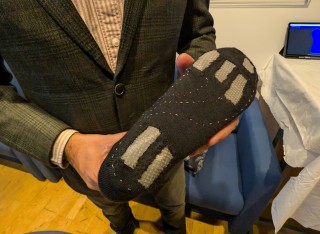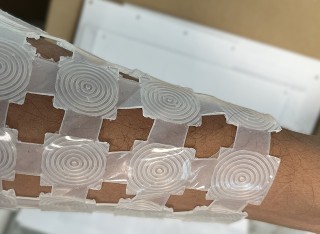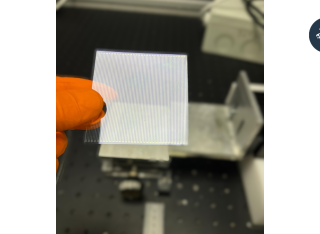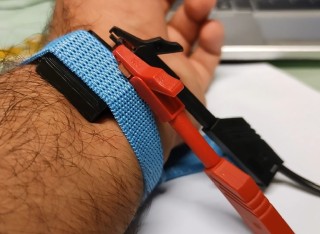
Dr Bhaskar Dudem
Academic and research departments
Faculty of Engineering and Physical Sciences, Advanced Technology Institute.About
Biography
Dr Bhaskar Dudem received his M.Tech. and Ph.D. from the Indian Institute of Technology Kanpur, India, and Kyung Hee University (KHU), South Korea, respectively. He worked at KHU as a postdoc for one year and as a teaching faculty member at K.L. University, India. His research has resulted in more than 40 publications in peer-reviewed journals and has an h-index of 28, with citations ~ of 2200 (Google Scholar).
Areas of specialism
My qualifications
Previous roles
Affiliations and memberships
News
In the media
Our joint collaborative research featured as the cover image in the May 2021 issue of Nano Energy.
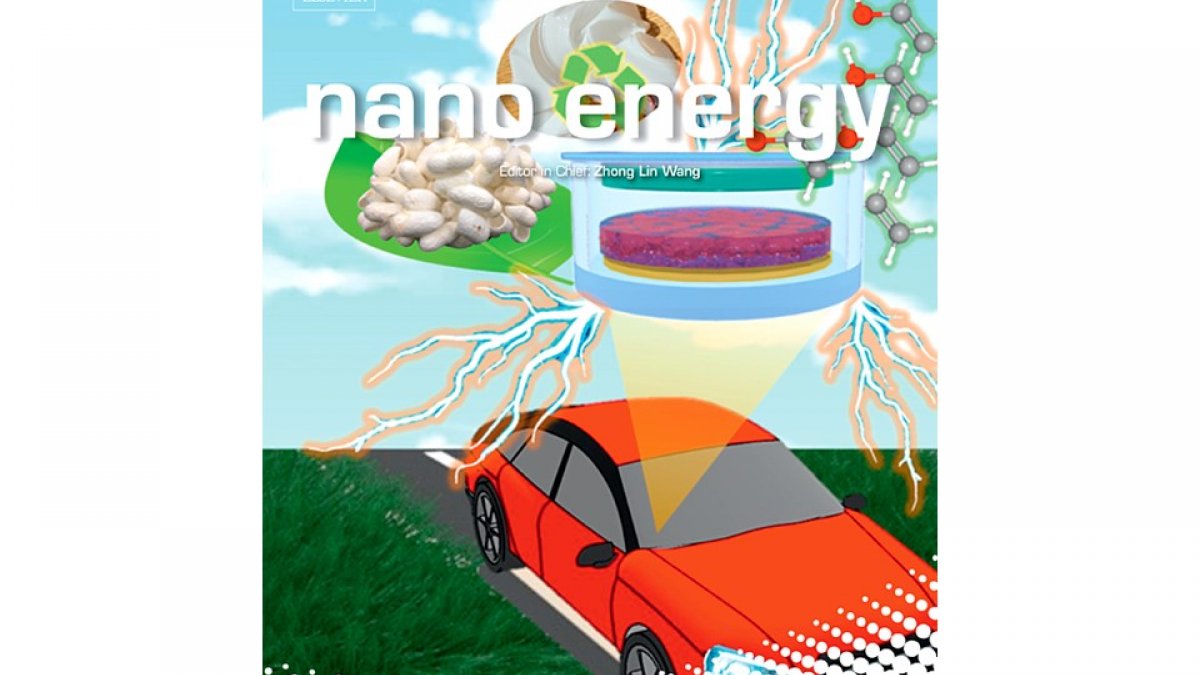 https://www.sciencedirect.com/journal/nano-energy/vol/83/suppl/C
https://www.sciencedirect.com/journal/nano-energy/vol/83/suppl/CSupervision
Postgraduate research supervision
PG
- Luca Barbieri (2022) (Co-supervisor) [Title: Triboelectric driven self-charging supercapacitor for self-powered electronics]
- Aravind Chandar Babu (2023) (Co-supervisor) [Title: Organic materials based flexible and stretchable triboelectric nanogenerators for self-powered posture identification]
UG
- David Patyk (2024) (Co-supervisor) [Title: Soft and Pouch-like Triboelectric Sensors for Biomechanical Monitoring.]
Publications
The vast potential of harnessing high entropy and abundantly available mechanical energy through triboelectric nanogenerators (TENGs) has attracted significant attention in recent years. However, the cost of harvesting this energy has often outweighed the energy collected. Recent advancements in TENGs for blue energy harvesting from water flow have shown great promise. In this study, we present a novel approach to optimize the performance of interdigitated electrode array-based TENGs operating in free-standing mode (IDA-FTENG) by introducing a gap-to-width ratio (GWR) relationship for the electrodes and its impact on the charge regeneration effects. We investigate the dependence of the charge regeneration effect on GWRs and the number of electrode pairs to enhance the performance of IDA-FTENGs, employing a rapid and industrially scalable laser scribing process for fabricating the devices. An optimized device, featuring a maximum of 34 interdigitated electrode grids, demonstrates a 140-fold increase in power density compared to conventional single electrode pair TENGs (SEP-TENGs). Furthermore, power density projections indicate that the optimized IDA-FTENGs can compete with current solar cells, if designed suitably. We showcase the applicability of the proposed IDA-FTENG devices in selfpowered sensors, autonomous wireless operations, security monitoring, and smart home systems.
Abstract Triboelectric nanogenerators (TENG) work on the principle of tribo and contact electrification, which is a common effect observed in daily life. TENGs are moving closer to commercialization, particularly for small scale energy harvesting and self-powered sensing. The toys and games industry has attracted a huge audience recently with the introduction of digital toys. In this paper we embedded TENGs to power up a toy and operate during its specific application. We have modified two potential electronic demonstrator applications using TENG for lobster toy (LT-TENG) and stress ball (SB-TENG) device. The LT-TENG device generates a maximum electrical response of 60 V/ 2 µA, with a power of 55 µW and power density of 0.065 µW/m2 at a load resistance value of 10 MΩ. Similarly, the SB-TENG device made of aluminum and PDMS as the triboelectric layers generates a maximum electrical output response of 800 V and 4 µA peak to peak current with an instantaneous power of 6 mW and a power density of 3.5 mW/m2 respectively at a load resistance of 10 MΩ. In addition, the layers of the TENGs are packed with polyethylene to maintain the performance of the nanogenerator under harsh environmental conditions, especially with humid environments. The water resistance studies proved that the packed SB-TENG is impervious to water. The LT-TENG device is accompanied by four LEDs, and the device lights up upon actuating the handle. The stress ball is connected with the measuring instrument to record the quantity of force at which the stress ball is pressed. The adopted approach paves the way to convert these traditional toys into battery-free electronic designs and its commercialization.
Wearable sensors are being widely utilized to monitor athletes' physiological conditions during sports performance, especially when activities are performed in extreme weather conditions, such as skiing, snowboarding, mountain biking, bicycle motocrossing, and rock climbing. Extreme weather conditions, e.g., cold temperatures, call for stable wearable self-power sensors whose properties and functionality are independent of the external temperature. In this work, we present a novel flexible composite material based on silk-glycerol hydrogel, whose temperature-independent mechanical and triboelectric properties are used for the realization of stable wearable self-power sensors. The proposed hydrogel shows good mechanical (minimum stretchability of around 130% and Young's Modulus of about 0.08 MPa) and triboelectric properties (maximum current output of 12.5 nA) independent of the temperature up to - 20 ^{\circ}\mathrm{C}. Moreover, the developed triboelectric nanogenerator (TENG) yields a linear relationship between the current and the applied compressive force up to 35 N, demonstrating the possibility to realize hydrogel-based TENG devices to be used as bio-mechanical sensors for wearable applications.
Ambient energy harvesting has great potential to contribute to sustainable development and address growing environmental challenges. Converting waste energy from energy-intensive processes and systems (e.g., combustion engines and furnaces) is crucial to reducing their environmental impact and achieving net-zero emissions. Compact energy harvesters will also be key to powering the exponentially growing smart devices ecosystem that is part of the Internet of Things, thus enabling futuristic applications that can improve our quality of life (e.g., smart homes, smart cities, smart manufacturing, and smart healthcare). To achieve these goals, innovative materials are needed to efficiently convert ambient energy into electricity through various physical mechanisms, such as the photovoltaic effect, thermoelectricity, piezoelectricity, triboelectricity, and electromagnetic power transfer. By bringing together the perspectives of experts in various types of energy harvesting materials, this Roadmap provides extensive insights into recent advances and present challenges in the field. Additionally, the Roadmap analyzes the key performance metrics of these technologies in relation to their ultimate energy conversion limits. Building on these insights, the Roadmap outlines promising directions for future research to fully harness the potential of energy harvesting materials for green energy anytime, anywhere.
Energy harvesters for smart wearables are gaining increasing attention world-wide. Among the various type of options availabel, triboelectric nanogenerators harvesting mechanical energy from human body movements are especially attractive. In this work, a flexible sandwich-type triboelectric nanogenerator (FS-TENG) based on ridged and biocompatible silicone elastomers and thermoplastic polyurethane is proposed. The proposed FS- TENG exhibits the open-circuit voltages and maximum power density of ~80 volts and 0.35 mW/cm 2 , respectively. This preliminary performance already makes the device extremely promising to power low energy smart wearable devices, as well as monitor pressure in bespoke biomedical applications.
Triboelectric nanogenerators (TENGs) developed using eco-friendly natural materials instead of traditional electronic materials are more favorable for biocompatible applications, as well as from a sustainable life-cycle analysis perspective. Microarchitectured silkworm fibroin films with high surface roughness and an outstanding ability to lose electrons are used to design TENGs. An alcohol-annealing treatment is utilized to strengthen the resistance of the silk film (SF) against humidity and aqueous solubility. Herein, for the first time, the distance-dependent electric field theoretical model is employed to optimize the TENG parameters to achieve high output, which shows excellent agreement with the experimental outputs of SF-based TENG. The alcohol-treated microarchitectured SF (AT-MASF) with a polytetrafluoroethylene positive contact exhibits a stable and high electrical output even in harsh environments. These studies can lead us closer to the attractive future vision of realizing biodegradable TENG systems for harness/sensing various biomechanical activities even under real/humid environments. The potential and real-time application of the proposed AT-MASF-based TENG is demonstrated by directly employing its electric power to drive a number of low-power portable electronics and for sensing in human-body centric activities.
A wearable and humidity-resistant cellulose-based flexible triboelectric nanogenerator (FTENG) device with high performance is proposed here. In this regard, cellulose extracted from cotton was combined with a poly(vinyl alcohol) solution and spray-coated onto a conductive-flexible substrate to develop a highly porous and flexible triboelectric film (HPF) which was employed in the fabrication of a FTENG. The dependence of electrical performance on the surface area was comprehensively studied by varying the surface area of the HPF. Furthermore, the HPF-based FTENG (HPF-FTENG) is lightweight, flexible, and robust; has a low processing cost; and can withstand a humid environment. Thus, the proposed device can be used not only to scavenge various mechanical disturbances within the surrounding environment but also to harvest mechanical energy underwater and in harsh environmental conditions. Finally, the electricity generated by the HPF-FTENG was employed to power various portable electronics, which supports a paradigm shift in the context of wearable and durable mechanical energy harvesters.
Battery-free and biodegradable sensors can detect biological elements in remote areas. The triboelectric nanogenerator (TENG) can potentially eliminate the need for a battery by simply converting the abundant vibrations from nature or human motion into electricity. A biodegradable sensor system integrated with TENG to detect commonly found disease-causing bacteria ( E. coli ) in the environment is showcased herein. In this system, d -mannose functionalized 3D printed polylactic acid (PLA) with the brush-painted silver electrode was used to detect E. coli by a simple carbohydrate–protein interaction mechanism. The adsorption capacity of d -mannose is generally altered by varying the concentration of E. coli resulting in changes in resistance. Thus, the presented biosensor can detect bacterial concentrations by monitoring the output current. The PLA TENG generates an output of 70 V, 800 nA, and 22 nC, respectively. In addition, tap water and unpasteurized milk samples are tested for detecting bacteria, and the output is measured at 6 μA and 5 μA, respectively. Further, the biosensor was tested for biodegradability in soil compost by maintaining constant temperature and humidity. This study not only proposes an efficient and fast method for screening E. coli but also gives important insights into the ability to degrade and long-term reliability of TENG-based sensor platforms.
Harvesting energy from renewable energy resources is an emerging research area to fulfil the globally rising energy demand owing to the enormous usage of various portable electronic systems. Mechanical energy is one of them and available abundantly in everyday human life such as ocean wave, human motion, raindrop fall, rotation energy, etc. Herein, the ferroelectric lithium niobate (LiNbO3) microparticles are prepared by a solid state reaction technique and further utilized for the fabrication of nanogenerator to efficiently harvest these mechanical energies. Ferroelectric materials exhibit much higher piezoelectric coefficients and a strong electric dipole movement, thus resulting in higher electrical performance of corresponding nanogenerators. Therefore, the as-prepared LiNbO3 is used to comparatively study the electrical performance of piezoelectric, triboelectric, and hybrid nanogenerators, respectively. In this regards, a composite layer is developed by incorporating the LiNbO3 into the triboelectric polymer (i.e., polydimethylsiloxane) to develop distinct types of nanogenerators and their electrical output performance is examined. Consequently, the hybrid nanogenerator (HNG) exhibits relatively higher performance as compared to the others, thanks to synergetic piezoelectric and triboelectric effects. Furthermore, the concentration of LiNbO3 added into the composite is further optimized to realize the highest electrical performance of HNG and it also exhibits good electrical stability and mechanical durability. Eventually, practical applications of the power generated by the HNG are further demonstrated to operate portable electronics.
Recently, hybrid nanogenerators (HNGs) based on the synergetic piezo/triboelectric effect have shown great promise for attaining high electrical output. In this work, microparticles (MPs) of calcium-doped barium zirconate titanate (Ca-BZT) are synthesized by a solid-state technique and subseqently dispersed into polydimethylsiloxane (PDMS) to prepare a composite film. This composite film is employed to develop an HNG device to efficiently harvest energy from various mechanical motions by individual piezoelectric or triboelectric effects, or a combined synergetic effect. The surface roughness, charge density, and dielectric permittivity of the composite films are significantly enhanced, resulting in an increase in output performance of the HNG device. The effect of Ca doping concentration on the ferroelectric characteristics of the BZT MPs and the output performance of the HNG device are systematically investigated. The BZT MPs with 2 mol% of Ca dopant optimize the high remnant polarization and piezoelectric coefficient of the Ca-BZT/PDMS composite. Moreover, the HNG device with the corresponding composite film also exhibits a maximum electrical output performance, with open-circuit voltage, short-circuit current, and power density values of 550 V, 34 mu A, and 23.6 W/m(2), respectively. Additionally, the mechanical stability and durability of the HNG device are investigated. To verify the practical applicability of the HNG, the generated output power is employed to demonstrate its ability to harvest biomedical energy and to power several light-emitting diodes as well as portable electronic devices.
Strategies to maximize the surface charge density across triboelectric layers while protecting it from humidity are crucial in employing triboelectric nanogenerators (TENGs) for commercial/real-time applications. Herein, for the first time, we propose the utility of crystalline silk microparticles (SMPs) to improve the surface charge density in materials like polyvinyl alcohol to realise its applicability for TENG devices. Moreover, these SMPs are extracted from discarded Bombyx mori silkworm cocoons by facile, inexpensive, and single-step alkaline-hydrolysis treatment. We examine the performance of these composites with counter-materials composed of waste PTFE plastic cups to show reuse in recycled products. The processing cost of TENG developed from recycled materials is not only low but eco-friendly. The TENG performance as a function of the concentration of SMPs is investigated and compared with the composite's work-function and surface-potentials, with the distance-dependent electric field theoretical model employed to optimize the performance. Consequently, the optimized TENG exhibits maximum output voltage, current, charge, and power density of ∼280 V, 17.3 μA, 32.5 nC, and 14.4 W·m−2, respectively, creating a highly competitive energy harvester that can conform to the rigorous needs of wearables and mobile applications. Furthermore, the fully packaged silicone rubber device protects it from humidity and enables the device utility for practical applications with a soft, comfortable, and skin-friendly interface.
Electronic waste produced by plastic, toxic, and semiconducting components of existing electronic devices is dramatically increasing environmental pollution. To overcome these issues the use of eco-friendly materials for designing such devices are attaining great concern. This current work presents a recycled materials-based triboelectric nanogenerator (TENG) made of plastic waste and carbon-coated paper wipes (C@PWs), in which the PWs also collected from a waste bin. The resultant C@PWs-based TENG is then used for powering low-power electronic devices, and later, to generate a Morse code from a wearable for autonomous communication. Other end-users in a customized LabVIEW programme decode the Morse code signals and read the transmitted message. With further redesigning, a 9-segment keyboard is developed using nine-TENGs, connected to an Arduino controller to display the 9-segment actuation on a computer screen. Based on the above analysis, our C@PW-TENG device is expected to have an impact on future self-powered sensors and IoT systems.
This Edited Volume “Nanogenerators and Self-Powered Systems” is a collection of reviewed and relevant research chapters, offering a comprehensive overview of recent developments in the field of nanotechnology and nanomaterials. The book comprises single chapters authored by various researchers and edited by an expert active in harnessing the ubiquitously available biomechanical energies to power portable electronics research area. All chapters are complete in themselves but united under a common research study topic. This publication aims at providing a thorough overview of the latest research efforts by international authors on nanotechnology and nanomaterials and opening new possible research paths for further novel developments.
Triboelectric nanogenerators (TENGs) which are one of the notable renewable energy harvesting devices have been demonstrated for various types of energy harvesting, sensing, and self-powered electronic applications. However, enhancing the electrical output performance by optimizing the TENG parameters and reducing its processing cost is still major issues to be resolved for practical and industrial utilization. Herein, we demonstrated a cost-effective and high-performance TENG using polyvinylidene fluoride (PVDF) and microstructure aligned polyvinyl alcohol (MS@PVA) polymers as negatively and positively polarized triboelectric materials, respectively. The PVDF film developed by a facile and cost-effective ultra-sonication process and its high electroactive beta-phase can be utilized to enhance the electric dipole-dipole interactions in the film, and also lead to an increase in its piezoelectric coefficient. Besides, the PVA film was produced by a simple solidification method and the microstructures on its surface are developed by merely corresponding inverse patterns on commercially available sandpaper. The resultant TENG with the PVDF and MS@PVA polymers exhibited maximum peak-to-peak open-circuit voltage, short-circuit current, and instantaneous output power density values of 230 V, 6 mu A, and 3.1 W/m(2), respectively. Ultimately, such a high electrical output generated by the TENG was employed to drive portable electronic devices such as displays and light-emitting diodes. (C) 2021 Elsevier Ltd. All rights reserved.
Additional publications
- H. Patnam, B. Dudem, et al., High-performance and robust triboelectric nanogenerators based on optimal microstructured poly (vinyl alcohol) and poly (vinylidene fluoride) polymers for self-powered electronic applications. Energy, 2021, 223, 120031.
- P. Manchi, S.A. Graham, B. Dudem, et al., Improved performance of nanogenerator via synergetic piezo/triboelectric effects of lithium niobate microparticles embedded composite films. Composite Science & Technology, 2021, 201, 108540.
- S.A. Graham, B. Dudem, et al., Integrated Design of Highly Porous Cellulose-Loaded Polymer-Based Triboelectric Films toward Flexible, Humidity-Resistant, and Sustainable Mechanical Energy Harvesters. ACS Energy Letters, 2020, 5, 2140.
- H. Patnam, B. Dudem, et al., Piezo/triboelectric hybrid nanogenerators based on Ca-doped barium zirconate titanate embedded composite polymers for wearable electronics. Composite Science & Technology, 2020, 188, 107693.
- B. Dudem, et al., Wearable and durable triboelectric nanogenerators via polyaniline coated cotton textiles as a movement sensor and self-powered system. Nano Energy, 2019, 55, 305.
- A.R. Mule†, B. Dudem†, et al., Humidity Sustained Wearable Pouch‐Type Triboelectric Nanogenerator for Harvesting Mechanical Energy from Human Activities. Advanced Functional Materials, 2019, 29, 1807779. [†co-first author]
- S.A. Graham, B. Dudem, et al., Engineering squandered cotton into eco-benign microarchitectured triboelectric films for sustainable and highly efficient mechanical energy harvesting. Nano Energy, 2019, 61, 505.
- B. Dudem, et al., High-Efficiency and Thermally Sustainable Perovskite Solar Cells with Sandpaper-Aided Flexible Haze/Antireflective Films. ACS Sustainable Chemistry & Engineering, 2019, 7, 12981.
- A.R. Mule, B. Dudem, et al., Wearable Single-Electrode-Mode Triboelectric Nanogenerator via Conductive Polymer-Coated Textiles for Self-Power Electronics. ACS Sustainable Chemistry & Engineering, 2019, 7, 16450.
- Sk.K. Hussain, B. Dudem, et al., Enhanced electrochemical performance via PPy encapsulated 3D flower-like bismuth molybdate nanoplates for high-performance supercapacitors. Applied Surface Science, 2019, 478, 846.
- B. Dudem, et al., Improved Light Harvesting Efficiency of Semitransparent Organic Solar Cells Enabled by Broadband/Omnidirectional Subwavelength Antireflective Architectures. Journal of Materials Chemistry A, 2018, 6, 14769.
- B. Dudem, et al., Enhancing the output performance of hybrid nanogenerators based on Al-doped BaTiO3 composite films: A self-powered utility system for portable electronics. Journal of Materials Chemistry A, 2018, 6, 16101.
- B. Dudem, et al., Triboelectric nanogenerators with gold-thin-film-coated conductive textile as floating electrode for scavenging wind energy. Nano Research, 2018, 11, 101.
- B. Dudem, et al., Enhanced Performance of Microarchitectured PTFE-Based Triboelectric Nanogenerator via Simple Thermal Imprinting Lithography for Self-Powered Electronics. ACS Applied Materials & Interfaces, 2018, 10, 24181.
- B. Dudem, et al., Highly-flexible piezoelectric nanogenerators with silver nanowires and barium titanate embedded composite films for mechanical energy harvesting. Applied Energy, 2018, 230, 865.
- D.H. Kim, B. Dudem, et al., Boosting light harvesting in perovskite solar cells by biomimetic inverted hemispherical architectured polymer layer with high haze factor as an antireflective layer. ACS Applied Materials & Interfaces, 2018, 10, 13113.
- B. Dudem, et al., Hierarchical Ag/TiO2/Si Forest-Like Nano/Micro-Architectures as Antireflective, Plasmonic Photocatalytic, and Self-Cleaning Coatings. ACS Sustainable Chemistry & Engineering, 2018, 6, 1580.
- D.H. Kim†, B. Dudem†, et al.,High-performance flexible piezoelectric-assisted triboelectric hybrid nanogenerator via polydimethylsiloxane-encapsulated nanoflower-like ZnO composite films for scavenging energy from daily human activities. ACS Sustainable Chemistry & Engineering, 2018, 6, 8525.
- A.R. Mule, B. Dudem, et al., High-performance and cost-effective triboelectric nanogenerators by sandpaper-assisted micropatterned polytetrafluoroethylene. Energy, 2018, 165, 677.
- D.H. Kim, B. Dudem, et al., Acid-free approach towards the growth of vertically aligned TiO2 nanorods as an efficient photoanode for dye-sensitized solar cells. Materials Research Bulletin, 2018, 105, 202.
- B. Dudem, et al., Nanopillar-array architectured PDMS-based triboelectric nanogenerator integrated with a windmill model for effective wind energy harvesting. Nano Energy, 2017, 42, 269.
- J.W. Leem, B. Dudem, et al., Biomimetic nano/micro double-textured silicon with outstanding antireflective and super-hydrophilic surfaces for high optical performance. RSC Advances, 2017, 7, 33757.
- B. Dudem, et al., CH3 NH3 PbI3 planar perovskite solar cells with antireflection and self-cleaning function layers. Journal of Materials Chemistry A, 2016, 4, 7573.
- B. Dudem, et al., Hybrid energy cell with hierarchical nano/micro-architectured polymer film to harvest mechanical, solar, and wind energies individually/simultaneously. ACS Applied Materials & Interfaces, 2016, 8, 30165.
- B. Dudem, et al., A multifunctional hierarchical nano/micro-structured silicon surface with omnidirectional antireflection and superhydrophilicity via an anodic aluminum oxide etch mask. RSC Advances, 2016, 6, 3764.
- J.W. Leem, B. Dudem, et al., Thermal-tolerant polymers with antireflective and hydrophobic grooved subwavelength grating surfaces for high-performance optics. RSC Advances, 2016, 6, 79755.
- J.W. Leem, M. Choi, B. Dudem, et al., Hierarchical structured polymers for light-absorption enhancement of silicon-based solar power systems. RSC Advances, 2016, 6, 55159.
- S.H. Kim, S.H. Lee, B. Dudem, et al., Fabrication and optical characterization of hybrid antireflective structures with zinc oxide nanorods/micro pyramidal silicon for photovoltaic applications. Optical Materials Express, 2016, 6, 4000.
- B. Dudem, et al., Highly transparent and flexible triboelectric nanogenerators with subwavelength-architectured polydimethylsiloxane by a nanoporous anodic aluminum oxide template. ACS Applied Materials & Interfaces, 2015, 7, 20520.
- B. Dudem, et al., Multifunctional polymers with biomimetic compound architectures via nanoporous AAO films for efficient solar energy harvesting in dye-sensitized solar cells. RSC Advances, 2015, 5, 90103.
- C.V. Reddy, C. Byon, B. Narendra, B. Dudem, et al., Effect of calcination temperature on cobalt substituted cadmium ferrite nanoparticles. Journal of Materials Science: Materials in Electronics, 2015, 26, 5078.
- C.V. Reddy, C. Byon, B. Narendra, D. Baskar, et al., Investigation of structural, thermal and magnetic properties of cadmium substituted cobalt ferrite nanoparticles. Superlattices and Microstructures, 2015, 82, 165.
- B. Dudem, et al., Broadband and wide-angle antireflective characteristics of nanoporous anodic alumina films for silicon-based optoelectronic applications. Applied Physics B: Lasers & Optics, 2015, 118, 439.
Conference Pro
